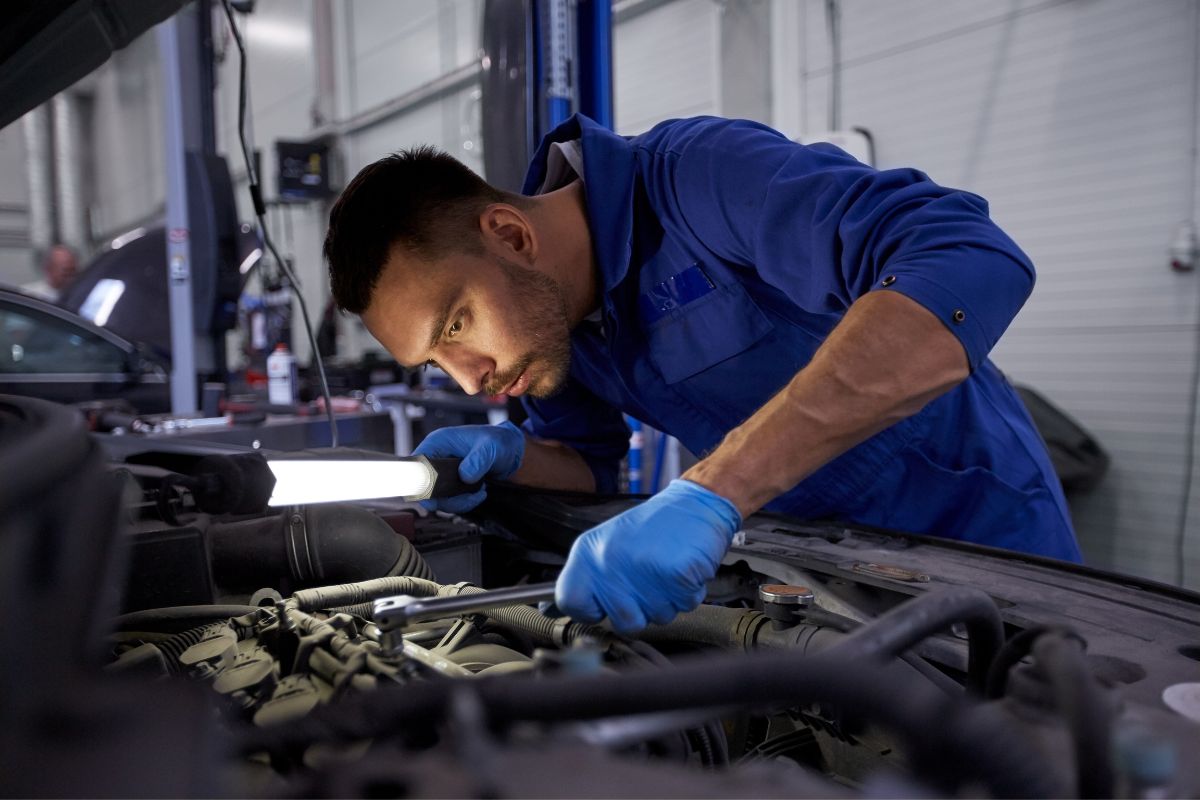
Common Used Engine Problems: Complete Diagnostic & Repair Guide
Key Takeaways
| Problem | Main Symptoms | Possible Causes |
|---|---|---|
| Engine Overheating | High temperature, steam, coolant loss | Radiator leaks, thermostat failure, water pump malfunction |
| Oil Leaks | Oil stains, burning smell, low oil level | Worn gaskets, damaged seals, loose drain plug |
| Engine Misfires | Rough idle, power loss, check engine light | Faulty spark plugs, clogged injectors, ignition coil failure |
| Electrical Issues | Starting problems, dim lights, battery drain | Dead battery, faulty alternator, corroded wiring |
| Fuel System Problems | Poor acceleration, stalling, hard starting | Clogged fuel filter, failed fuel pump, dirty injectors |
| Cooling System Failure | Overheating, coolant leaks, poor heater | Water pump failure, radiator blockage, hose leaks |
Used engines offer excellent value for automotive repairs and restoration projects, but they can present unique challenges. Understanding common problems and their solutions helps ensure reliable performance and longevity from your used engine investment.
This comprehensive guide covers the most frequent issues encountered with used engines, providing practical diagnostic steps and effective solutions to keep your vehicle running smoothly.
Used Engine Inspection Checklist
Before purchasing or installing a used engine, perform these essential checks:
| Inspection Point | What to Check | Red Flags |
|---|---|---|
| Compression | Even compression across cylinders | Variations >10% between cylinders |
| Oil Condition | Clean oil, no metal particles | Black oil, metal shavings, milky appearance |
| Coolant System | Clear coolant, no leaks | Brown coolant, oil contamination, pressure loss |
| External Condition | Clean surfaces, intact mounts | Heavy corrosion, cracked blocks, damaged mounts |
| Documentation | Service history, mileage records | No documentation, unclear history |
1. Engine Overheating Problems
Causes
- Coolant leaks from radiator, hoses, or water pump
- Faulty thermostat stuck closed or open
- Blocked radiator core from debris or corrosion
- Water pump impeller damage or bearing failure
- Insufficient coolant mixture or air pockets
Symptoms
- Temperature gauge reading high or in red zone
- Steam emanating from engine bay
- Coolant puddles under parked vehicle
- Sweet smell of antifreeze
- Engine knocking or pinging sounds
Solution
- Pressure test cooling system to locate leaks
- Replace thermostat and housing gasket (R350-R650)
- Flush radiator and replace if blocked (R1,800-R3,500)
- Replace water pump if bearing noise present (R1,200-R2,800)
- Bleed air pockets and refill with proper coolant mixture
DIY Difficulty / Hours
- Coolant level check: Easy / 0.2 hours
- Thermostat replacement: Moderate / 1.5 hours
- Water pump replacement: Difficult / 4-6 hours
- Professional cooling system service: R2,500-R4,500
For comprehensive cooling system diagnosis and repair guidance, see our detailed cooling system problems guide.
Overheating Warning
Never continue driving an overheating engine. Stop immediately and allow cooling. Overheating can cause warped cylinder heads, blown head gaskets, and complete engine failure.
2. Oil Leak Problems
Causes
- Worn valve cover gaskets from age and heat
- Deteriorated oil pan gasket from road debris
- Failed oil filter housing gasket
- Loose oil drain plug or damaged threads
- Worn crankshaft or camshaft seals
Symptoms
- Dark stains under parked vehicle
- Burning oil smell during operation
- Oil level dropping between changes
- Smoke from engine bay or exhaust
- Oil residue on engine surfaces
Solution
- Clean engine to identify exact leak location
- Replace valve cover gasket (R350-R750)
- Replace oil pan gasket if accessible (R450-R1,200)
- Tighten drain plug with new washer (R15-R35)
- Replace main seals if severely leaking (R2,500-R4,500)
DIY Difficulty / Hours
- Valve cover gasket replacement: Moderate / 2-3 hours
- Oil pan gasket replacement: Difficult / 3-5 hours
- Drain plug repair: Easy / 0.5 hours
- Professional leak diagnosis: R650-R1,200
Leak Detection Tip
Use UV dye in engine oil to accurately locate leak sources. Clean the engine first, add dye, run for 15 minutes, then inspect with UV light.
3. Engine Misfire Problems
Causes
- Worn or fouled spark plugs beyond service life
- Failed ignition coils producing weak spark
- Clogged fuel injectors restricting flow
- Low compression from worn piston rings
- Vacuum leaks causing lean air-fuel mixture
Symptoms
- Rough idle with engine shaking
- Loss of power during acceleration
- Check engine light flashing
- Poor fuel economy
- Engine hesitation or stumbling
Solution
- Replace spark plugs every 60,000-100,000 km (R80-R200 each)
- Test and replace faulty ignition coils (R450-R850 each)
- Professional fuel injector cleaning (R150-R300 per injector)
- Compression test to verify cylinder health
- Repair vacuum leaks in intake system
DIY Difficulty / Hours
- Spark plug replacement: Moderate / 1-2 hours
- Ignition coil replacement: Easy / 0.5 hours per coil
- Compression testing: Moderate / 1 hour
- Professional injector cleaning: R1,200-R2,400
Misfire Code Reading
Modern engines provide specific cylinder misfire codes (P0301-P0308). Use an OBD scanner to identify which cylinder is misfiring for targeted diagnosis.
4. Electrical System Problems
Causes
- Old or degraded battery with reduced capacity
- Faulty alternator not charging properly
- Corroded electrical connections
- Damaged wiring harness from age or rodents
- Failed engine control module (ECM)
Symptoms
- Difficulty starting or no-start condition
- Dimming headlights or interior lights
- Battery warning light on dashboard
- Engine stalling or erratic idle
- Radio or electrical accessories malfunctioning
Solution
- Test battery voltage and load capacity (12.6V at rest)
- Check alternator output voltage (13.5-14.4V running)
- Clean and tighten all electrical connections
- Inspect wiring for damage and repair as needed
- Professional ECM diagnosis and programming if required
DIY Difficulty / Hours
- Battery testing: Easy / 0.5 hours
- Alternator testing: Moderate / 1 hour
- Connection cleaning: Easy / 1 hour
- Professional electrical diagnosis: R800-R1,500
Electrical Safety Warning
Always disconnect the battery negative terminal before working on electrical systems. Wear safety glasses and avoid short circuits that can cause fires or damage.
5. Fuel System Problems
Causes
- Clogged fuel filter from contaminated fuel
- Failed fuel pump due to wear or contamination
- Dirty fuel injectors from poor fuel quality
- Water or debris in fuel tank
- Faulty fuel pressure regulator
Symptoms
- Engine hesitation or stumbling under load
- Hard starting, especially when hot
- Stalling during idle or deceleration
- Reduced power and acceleration
- Poor fuel economy
Solution
- Replace fuel filter every 40,000-80,000 km (R200-R500)
- Test fuel pump pressure and volume output
- Professional fuel system cleaning service
- Drain and clean fuel tank if contaminated
- Replace fuel pump if pressure is below specification
DIY Difficulty / Hours
- Fuel filter replacement: Moderate / 1-2 hours
- Fuel pressure testing: Moderate / 1 hour
- Fuel pump replacement: Difficult / 3-5 hours
- Professional fuel system service: R1,500-R3,500
Fuel Quality Tip
Use fuel additives monthly and premium fuel from reputable stations. Poor fuel quality is the leading cause of fuel system problems in used engines.
6. Cooling System Problems
Causes
- Water pump bearing failure or impeller damage
- Thermostat malfunction affecting temperature control
- Radiator corrosion or internal blockages
- Cooling hose deterioration from age
- Head gasket failure allowing coolant mixing
Symptoms
- Engine running too hot or too cool
- Coolant loss without visible external leaks
- White smoke from exhaust (head gasket)
- Milky oil indicating coolant contamination
- Poor cabin heater performance
Solution
- Replace water pump preventively at timing belt service
- Test and replace thermostat (R200-R450)
- Flush cooling system every 60,000 km
- Pressure test system to identify internal leaks
- Head gasket replacement if cylinder pressure testing confirms failure
DIY Difficulty / Hours
- Thermostat replacement: Moderate / 1.5 hours
- Cooling system flush: Easy / 1 hour
- Water pump replacement: Very Difficult / 5-8 hours
- Professional cooling system diagnosis: R650-R1,200
Head Gasket Warning
White exhaust smoke and milky oil are signs of head gasket failure. This requires immediate attention to prevent catastrophic engine damage.
Used Engine Preventive Maintenance Schedule
First 1,000 km (Break-in Period)
- Change engine oil and filter
- Check all fluid levels daily
- Monitor for leaks or unusual noises
- Avoid high RPM or heavy loads
Every 5,000 km
- Change engine oil and filter
- Inspect belts and hoses
- Check coolant level and condition
- Test battery and electrical connections
Every 15,000 km
- Replace air filter
- Inspect spark plugs
- Check fuel filter condition
- Test compression in all cylinders
Every 30,000 km
- Replace spark plugs and ignition components
- Flush cooling system completely
- Replace fuel filter
- Professional fuel system cleaning
Every 60,000 km
- Replace timing belt (if equipped)
- Replace water pump preventively
- Inspect and replace worn gaskets
- Comprehensive engine inspection
Diagnostic Video Guide
FAQ
How many kilometers should a used engine have?
Look for engines with 80,000-150,000 km for the best balance of remaining life and value. Avoid engines over 200,000 km unless they have exceptional service history.
What should I check before buying a used engine?
Perform compression tests, check oil condition, inspect for leaks, verify service history, and ensure the engine runs smoothly without unusual noises or smoke.
How long do used engines typically last?
Well-maintained used engines can last 100,000+ additional kilometers. Lifespan depends on maintenance history, operating conditions, and how well problems are addressed.
Should I rebuild or replace a used engine?
Replace if core components (block, heads, crankshaft) are damaged. Rebuild if only wear items (gaskets, seals, bearings) need attention. Consider cost vs. vehicle value.
What’s the break-in procedure for a used engine?
Change oil after first 1,000 km, avoid high RPM or heavy loads for 5,000 km, monitor all fluid levels closely, and address any leaks immediately.
How much should I budget for used engine problems?
Budget R5,000-R15,000 annually for maintenance and minor repairs. Major issues like head gaskets or timing chains can cost R8,000-R25,000.
Common Used Engine Red Flags
Avoid Engines With:
- Metal shavings in oil
- White or brown coolant
- Excessive oil consumption (>1L per 1,000km)
- Low or uneven compression
- Visible external damage or corrosion
- No service history documentation
Warning Signs During Operation:
- Unusual knocking or rattling noises
- Excessive smoke from exhaust
- Overheating within first 30 minutes
- Oil pressure warning lights
- Irregular idle or stalling
Conclusion
Used engines can provide excellent reliability and value when properly selected, inspected, and maintained. Understanding common problems and their solutions helps you make informed decisions and maintain optimal performance.
Regular preventive maintenance, quality parts, and prompt attention to developing issues are key to maximizing used engine lifespan. When problems do occur, proper diagnosis and professional repair ensure continued reliable operation.
For quality replacement engines and professional engine services, explore our selection of reliable used engines for sale and comprehensive engine services to keep your vehicle running at its best.
Remember that investing in proper maintenance and quality repairs is always more cost-effective than dealing with catastrophic engine failure. Choose quality parts, follow maintenance schedules, and address issues promptly for the best results from your used engine.
Important Disclaimer
This content is for informational purposes only and is based on research from automotive industry sources. Engine Finder is not a certified automotive repair facility. Always consult with qualified automotive professionals before performing any repairs or maintenance. Improper repairs can result in personal injury, property damage, or vehicle malfunction. We assume no responsibility for actions taken based on this information.
